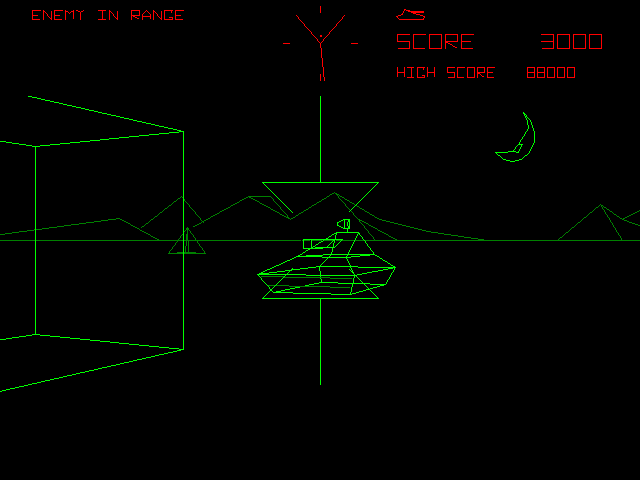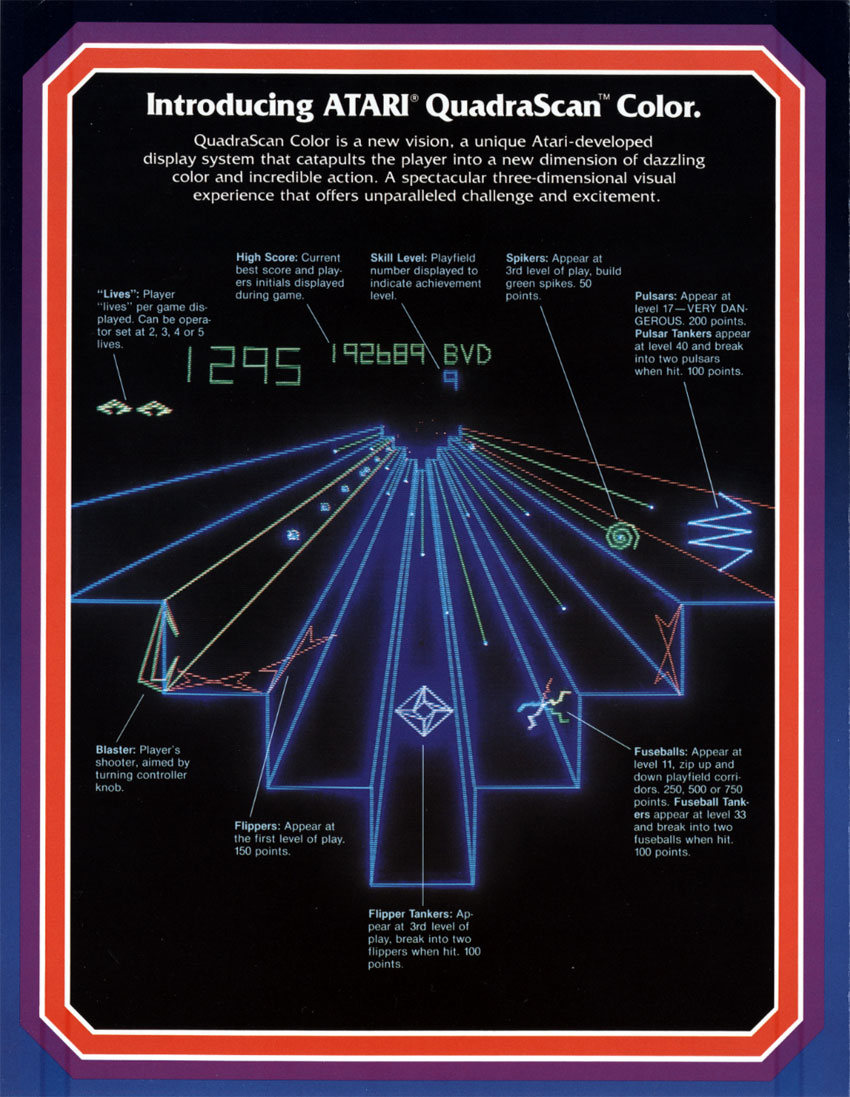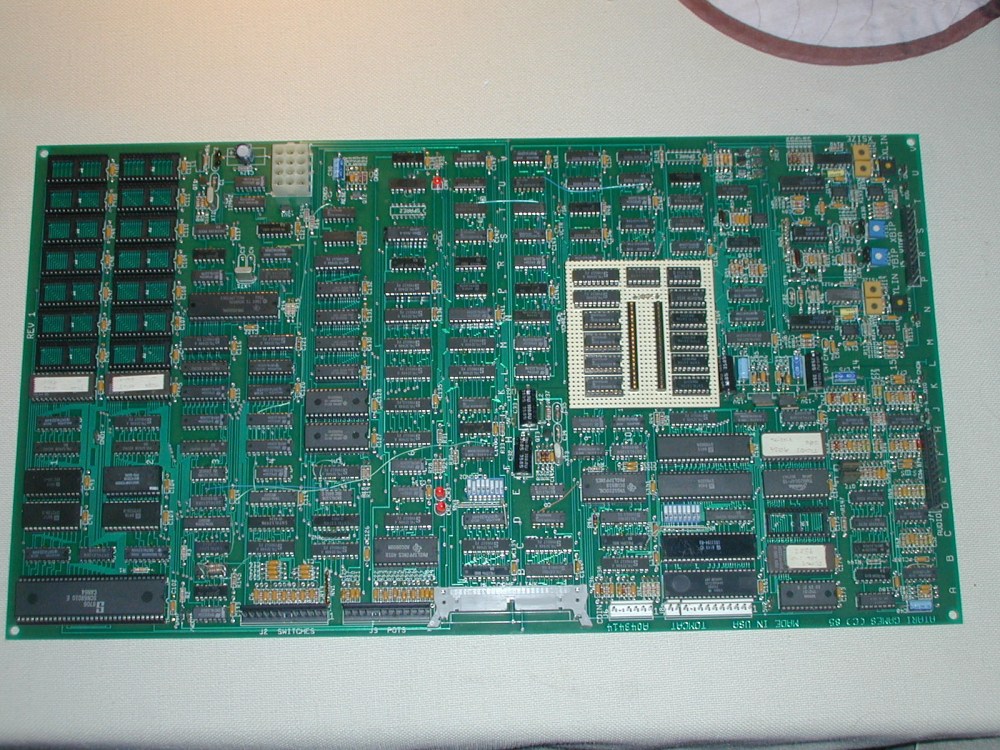With a total roster of thirteen vector releases, Atari were undoubtedly the kings of wire-frame arcade games. It all began with Lunar Lander and then Asteroids. Released in 1979, these two games heralded the company’s innovative intent, and arguably began the Golden Age of videogames.

Whereas traditional raster arcade monitors house an electron gun that sweeps a beam from left to right, and from top to bottom (in much the same way you are reading this article), a vector monitor draws lines between two points. The gun is capable of redrawing these lines over and over very quickly, at multiple points across the screen. The result is that no fading of the images produced can be seen by the naked eye. Vector, or “XY” visuals are ‘simpler’ but the distinctive glow that these monitors produce is hypnotic – graphics are sharper, cleaner, brighter and more pronounced. There are no pixels on a vector display, and apart from a few exceptions, none of the shapes are filled in – this is what gives these games their unique wireframe look. Any collector will tell you that nothing beats the glow of a vector-based arcade game in a dark room.
After the success of Asteroids, Atari followed up with a slew of vectors, including Battlezone (its first ever game to achieve revenue of $500 a week during field testing), Red Baron and Asteroids Deluxe. The latter was the last single colour vector game released by the company. “Colour” up to this point was achieved with the use of coloured gels placed on the game’s screen.

A major leap forward came with the release of Tempest in 1981 – Atari’s first colour vector game on it’s new “Quadrascan Color” vector monitor. Capable of displaying multiple vivid colours on screen, Dave Theurer’s masterpiece heralded a new era of full colour vector displays and was a huge success.

1982 saw the release of Space Duel, Gravitar, Black Widow and Quantum – all in colour (and for the record, housed in some of Atari’s most beautiful cabinets). Ambitious games all four, but none could really be regarded as a commercial success.
But then came 1983’s Star Wars. Securing the world’s most famous IP meant Atari had to deliver the goods, and this spectacular game is much loved and highly collectable to this day.
Atari’s final vector games came in the shape of Owen Rubin’s gloriously detailed Major Havoc and the follow up to Star Wars – The Empire Strikes Back. Both are great games, but their release in 1983 and 1985 respectively, coincided with the sudden downturn in the popularity of arcades. The market was now saturated with me-too game titles and consumers were no longer dumping millions of quarters into arcade machines.

The lingering issue with vector arcade games was one of reliability. Despite their technical brilliance, these displays were horribly unreliable in their day (and judging by the amount of time I spend with my head inside the back of my Tempest holding a torch and multimeter, I guess not much has changed). Operators demanded “place and forget” machines that required little intervention on their part. They wanted machines that would sit on the arcade floor, run without problems and take money again and again.
Jed Margolin knew this, but his technical interest in vector hardware, and a burning desire to create a 3D war game set in space, is what drove him to take a job with Atari in 1979 as a hardware engineer.
Jed’s Atari resumé is mightily impressive, he worked on a long list of games, including vector titles Battlezone, Tempest, Star Wars and Empire Strikes Back. Indeed it was his own partially completed game, Warp Speed, that formed the basis of what was to become the seminal Star Wars.
As an aside, Jed tells a great story about the reliability of Atari’s Quantum game, showcased at a trade show in 1983. Not quite finished at that stage, the game had a tendency to break down every 12 minutes. So he spent his entire time stood next to Quantum, casually reaching around the back of the machine every 10 minutes or so and switching it off and back on again – just to keep the thing running, and to give prospective buyers no reason not to place orders. The bug causing the shutdown was eventually fixed before release.

After working on Star Wars, Jed started on a new project in 1983. Given the moniker Tomcat, he took the role of lead programmer, with support from Hans Hansen and Doug Snyder who worked on graphic design. The game was intended to run on new colour vector hardware, bespoke built by Jed in order to cope with the vision he had for Tomcat. He started to build the hardware based on processors made by National Semiconductor, who up to that point, were suppliers of components to Atari. Jed called his rep at the firm to ask a few questions about some trouble he was having with the processor, only to receive this response:
Umm, well, Jed, my title is Major Accounts Representative, and, umm, uh…
Jed finished his sentence for him:
We are no longer a ‘Major Account’ right?
The rep replied simply:
Yes.
Jed was passed to an underling at the company, who didn’t return his calls. (An interesting insight into just how far Atari had fallen at that point in time).
Perhaps the writing was on the wall, but rather than give up, he decided to scrap the project and start again, this time using a processor made by Motorola, the powerful 68010. A TMS32010 Digital Signal Processor was utilised for math calculations, a sound section used what was at the time new Yamaha FM ‘synthesis’ integrated circuits, and an revised Analog Vector Generator which vastly improved the look of the vector lines drawn on screen. And it was all squeezed onto one board – truly state of the art gear at the time.

Considered a research project, Atari was initially unwilling to assign a full complement of project personnel to the game, so Jed ran largely solo. As part of what Atari called the “Applied Research Group”, his brief was to develop new hardware to run the game, then write some 3D software to demonstrate its capabilities. Assuming that was achieved, he could then pitch what he had internally, and recruit a team to get the game built.
As a starting point, he petitioned lead Star Wars programmer Greg Rivera, and persuaded him to modify his original code to give Jed some software hooks that would allow him to add his own new graphics. Working with Hans and Doug, they came up with some new 3D models – some based on the Bradley Trainer version of Battlezone (which is another subject for another time).
They designed a tank:

A helicopter (sans rotors at this point):

And a jetfighter (the Tomcat):

Ultimately, only the helicopter could be “flown” at this early stage, but with the addition of a heads up display, a green grid representing the ground populated with some simple objects, a blue horizon line and some stars in the sky, the player was able to use these visual references to avoid becoming disorientated. Here are some screen caps of the game:




Players could even barrel roll the aircraft:

What was created was a demo that was pretty rudimentary (there were no goals as such, no scoring or sounds, and nothing really to actually do), but the player did have full 3-axis control – something not present in the largely “on-rails” shooter Star Wars. Jed had managed to take things a stage further by demoing two cabinets linked together, with both players flying around the same playfield in true WW1 Dogfight style!
Thankfully Jed has captured the demo in action. The following video gives you an idea of what Jed had achieved. Bear in mind this is a raster scan recording on a camera. Capturing an XY display in raster scan creates artefacts. Compressing the video for YouTube creates even more artefacts. I’m told the visuals themselves were stunning – way ahead of other vector games, all thanks to Jed’s cocktail of new hardware which made the vectors smooth, bright and compelling. This is the only footage of the game known to exist:
Compare what you see there with any other Atari XY game. It was a huge leap in technical terms. Atari’s vector games had of course evolved in complexity since Lunar Lander through to Major Havoc. But it was clear that Tomcat would have been a radical departure from everything that preceded it – the advance in game play potential is obvious. As Jed explains, there was scope for some real complexity in the game:
I wanted Tomcat to have real aerodynamics. I added the option of a computer-aided mode so people could play it without having to know how to fly. The intent was always to have a two-player game as an option. Not only would it be fun but I had a notion to collect data on human combat strategies so when you played the computer it would act human. The problem playing a computer is that the computer tends to be either “too good” or it cheats. Players really hate it when the computer cheats. All of these things were going to be put in the final game.
Sadly, events conspired against Tomcat: Jed was unable to persuade any of Atari’s designers to work on the game, some of the hardware he was using was effectively scrapped by the companies producing it, and it was very clear that Atari were starting to regard vector games as a thing of the past. Cost, reliability and little desire to innovate by 1983, were all factors in the decision making process. Throw into the mix the small matter of a certain laser disc game called Firefox that was imminently launching, but had run into deep technical problems. Jed’s bosses were literally begging him to help get that sorted out and released instead.
But all was not lost. Jed was soon invited by Rick Moncrief, project lead of a team developing what would become Atari’s Hard Drivin’, and was able to take his prototype with him, and use it to build an early vector version of the game (yes, Hard Drivin’ started life as a vector game). As Jed puts it:
I expected my demo to become a game and was disappointed that it didn’t get any support from the game designers. But as I was able to use what I learned from it to design the Hard Drivin’ hardware, Tomcat became (by definition) a hardware demo/research project.

Jed holds fond memories of his interactions with vector XY games:
There is something different about XY. Perhaps it is because an object is completely drawn before moving on to the next one, while in a raster game objects are drawn in pieces at different times on different scan lines.
It may simply be nostalgia; the old memory of when XY games had so much better resolution than their raster brethren. And, since there haven’t been any new XY games in over 30 years, we may associate XY games with that period of our lives.
Some people are interested in XY games the same way other people are interested in old radios. Some people are purists; they would rather have a non-working old radio than use a few modern parts to get it going. Some people are perfectly happy with a modern replication; they are in love with the idea of an old radio. Either way is fine. The nice thing about a hobby is that you don’t have to justify it.
Tomcat now lives in Jed’s garage housed in a Star Wars upright cabinet (Tomcat never got to the point of having it’s own bespoke cab built). The remaining hardware, which still works incidentally, is testament to what could have became Atari’s final swansong to arcade vector releases. Who knows what impact the final game could have had on the market. What a shame it was just too late for Atari to get behind it and develop the game further. I suspect we would have been in for a real treat.
But with the way things panned out, if we regard Hard Drivin’ as the final output from his demo, it is hard from where I’m sitting to regard Tomcat as a failure.
I am hugely indebted to Jed Margolin for his help and candour in researching this article. Thank you Jed.
See you all next week.
Tony
Footnote: The Tomcat story took an interesting twist many years later. After leaving Atari in 1992, and inspired by his work on Tomcat, Jed filed a patent idea he had which outlined a safety feature to be placed in commercial airliners’ cockpits. Called “A Pilot Aid Using A Synthetic Environment”, the device would combine GPS and terrain mapping software to give pilots a clear indication of where they were spatially in the air, regardless of atmospheric conditions like bad weather (in simple terms, it was a virtual screen to help prevent planes from flying into the side of mountains). A company developing a similar system sued Jed, wrongly thinking that his patent was already filed elsewhere, and didn’t require them to licence it in some way. Amongst a long list of typically mad litigious demands, they requested he immediately hand over the Tomcat software and hardware that was in his possession – believing it was somehow directly related to his patent (which of course it wasn’t – it was a humble videogame demo – and GPS didn’t even exist back in 1983). The case was eventually settled before it got to court, but it’s interesting to think how far down the legal road things might have been taken. It is entirely possible that Jed could have been subpoenaed to demonstrate his 30 year old game in a courtroom somewhere in Arizona. I think a public gallery full of arcade collectors would have been very impressed….

Once again, an amazing post. Thank you, Tony!
LikeLike
Nice article Tony
LikeLike
Another great read – i am somehow addicted to your site even though i was just a occasional arcade gamer back in the day.
LikeLike
Some people are still making vector ‘arcade’ games:
LikeLike
It would be awesome if some classic arcade enthusiasts would finish this game for modern PCs as an opensource project, and/or someone would start a kickstarter project to make a color vector monitor that can be used as an external vector video game display for PCs. (Make sure to write display / driver / graphics libraries for Python, QB64, MAME, etc.!
LikeLiked by 1 person